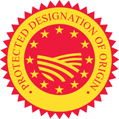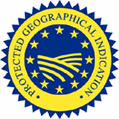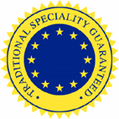Meats and Sausages
European Certificates of Origin
The sausage gets its individual character when it is supported by the name of the region it has originally come from. Throughout Europe there is a huge assortment of great foods. When a product acquires a reputation extending beyond national borders, it can face competition from other products which may pass themselves off as the genuine article and take the same name.
Our hats go off to the French who invented the idea in the 1930’s to protect their regional wines. The system used in France from the early part of the twentieth century is known as the Appellation d’Origine Contrôlée (AOC). Items that meet geographical origin and quality standards may be endorsed with a government-issued stamp which acts as an official certification of the origins and standards of the product to the consumer. In 1992, the European Union created the following systems to promote and protect food products:

PDO - Protected Designation of Origin (PDO) - covers the term used to describe foodstuffs which are produced, processed and prepared in a given geographical area using recognized know-how.

PGI - Protected Geographical Indication (PGI) - the geographical link must occur in at least one of the stages of production, processing or preparation.

Traditional Specialty Guaranteed (TSG) - does not refer to the origin but highlights traditional character, either in the composition or means of production.
This system is similar to the French Appellation d’Origine Contrôlée (AOC) system, the Denominazione di Origine Controllata (DOC) used in Italy, and the Denominación de Origen system used in Spain. The law (enforced within the EU and being gradually expanded internationally via bilateral agreements of the EU with non-EU countries) ensures that only products genuinely originating in that region are allowed in commerce as such. The purpose of the law is to protect the reputation of the regional foods and eliminate the unfair competition and misleading of consumers by non-genuine products, which may be of inferior quality or of different flavor.
These laws protect the names of wines, cheeses, hams, sausages, olives, beers, and even regional breads, fruits, and vegetables. As such, foods such as Gorgonzola, Parmigiano Reggiano, Asiago cheese, Camembert de Normandie and Champagne can only be labelled as such if they come from the designated region. To qualify as Roquefort, for example, cheese must be made from the milk of a certain breed of sheep, and matured in the natural caves near the town of Roquefort in the Aveyron region of France where it is infected with the spores of a fungus (Penicillium roqueforti) that grows in those caves. Fresh meat and meat based products (cooked, salted, smoked, etc.) are also covered by the law and many countries have already filed their products with the European Commission.
European Certificates of Origin don’t come easy and only a few countries were able to obtain them. Countries which were granted most Certificates of Origin for Meat Products and Sausages are: Portugal, Italy, Spain, France, and Germany. It shall be noted that countries that have joined the European Union at later dates still have products pending approval.
Any product that bears a certificate is certified as being unique and of the highest quality. It can be said that those certified products represent the best traditionally made products that the world has to offer. At the time of this writing (June 2010) the following countries received registrations for their meat products:
- Austria
- Tiroler Speck PGI 13/06/1997
- Gailtaler Speck PGI 11/07/2002
- Belgium
- Jambon d’Ardenne PGI 21/06/1996
- France
- Canard â foie gras du Sud-Quest PGI 27/06/2000
- Jambon sec etnoix de jambon sec des Ardennes PGI 26/02/2002
- Jambon de Bayonne PGI 07/10/1998
- Boudin blanc de Rethel PGI 26/02/2002
- Germany
- Thüringer Leberwurst PGI 18/12/2003
- Thüringer Rostbratwurst PGI 18/12/2003
- Thüringer Rotwurst PGI 18/12/2003
- Schwarzwälder Schinken PGI 24/01/1997
- Nürnberger Bratwürste; Nürnberger Rostbratwürste PGI 16/07/2003
- Greußener Salami PGI 09/04/1998
- Ammerländer Schinken; Amerländer Knochenschinken PGI 24/01/1997
- Ammerländer Dielenrauchschinken; Ammerländer Katenschinken PGI 24/02/1997
- Hungary
- Szegedl szalámi; Szegedl téliszalámi PDO 15/12/2007
- Budapesti téliszalámi PGI 21/04/2009
- Italy
- Prosciutto di S. Danielle PDO 21/06/1996
- Salame di Varzi PDO 21/06/1996
- Soprèssa Vicentina PDO 19/03/2003
- Valle d’Aosta Lard d’Arnad PDO 02/07/1996
- Valle d’Aosta Jambon de Bosses PDO 02/07/1996
- Soppressata di Calambria PDO 21/01/1998
- Salciccia di Calambria PDO 21/01/1998
- Salamini italiani alla cacciatora PDO 08/09/2001
- Salame Piacentino PDO 02/07/1996
- Salame Brianza PDO 21/06/1996
- Prosciutto Veneto Berico-Euganeo PDO 21/06/1996
- Prosciutto Toscano PDO 02/07/1996
- Prosciutto di Parma PDO 05/02/2008
- Prosciutto di Modena PDO 21/06/1996
- Prosciutto di Carpegna PDO 02/07/1996
- Pancetta Placentina PDO 02/07/1996
- Pancetta di Calabria PDO 21/01/1998
- Culatello di Zibello PDO 02/07/1996
- Coppa Placentina PDO 02/07/1996
- Capocollo di Calambria PDO 21/01/1998
- Ciauscolo PGI 11/08/2009
- Speck dell’Alto Adige PGI 13/06/1997
- Zampone Modena PGI 19/03/1999
- Salame S.Angelo PGI 26/09/2008
- Salame d’oca di Mortara PGI 25/06/2004
- Salame Cremona PGI 23/11/2007
- Prosciutto di Norcia PGI 13/06/1997
- Lardo di Colonnata PGI 27/10/2004
- Cotechino Modena PGI 19/03/1999
- Breasola della Valtellina PGI 02/07/1996
- Ireland
- Timoleague Brown Pudding PGI 07/11/1000
- Luxembourg
- Salaisons fumées, marque nationale grand-duche de Luxembourg PGI 23/11/1996
- Portugal
- Presunto de Alentejo, Paleta de Alentejo PDO 26/09/2008
- Presunto de Barrancos PDO 21/06/1996
- Salpicão de Vinhais PGI 19/06/1998
- Salpicão de Barroso-Montalegre PGI 16/02/2007
- Presunto de Vinhais/Presunto Bisaro de Vinhais PGI 17/07/2008
- Linquiça de Portalegre PGI 27/09/1997
- Linquiça de Baixo Alentejo; Chouriço de carne de Baixo Alentejo PGI 16/02/2007
- Chouriço Mouro de Portalegre PGI 27/08/1997
- Chouriço de Portalegre PGI 27/09/1997
- Chouriça de carne de Vinhais; Linguiça de Vinhais PGI 19/06/1998
- Chouriço de Carne de Estremoz e Borba PGI 09/07/2004
- Chouriça de Carne de Barroso-Montalegre PGI 16/02/2007
- Chouriço de Abóbora de Barroso-Maontalegre PGI 16/02/2007
- Chouriço azedo de Vinhais PGI 26/09/2008
- Butelo de Vinhais; Bucho de Vinhais; Chouriço de Ossos de Vinhais PGI 26/07/2008
- Chouriça doce de Vinhais PGI 26/07/2008
- Sangueira de Barroso-Montalegre PGI 16/02/2007
- Portugal Presunto de Camp Maior e Elvas; Paleta de Campo Maior e Elvas PGI 26/09/2008
- Presunto de Santana de Serra; Paleta de Santana de Serra PGI 26/09/2008
- Presunto de Barroso PGI 13/11/1996
- Palo de Beja PGI 16/02/2007
- Painho de Portalegre PGI 27/09/1997
- Paia de Toucinho de Estremoz e Borba PGI 09/07/2004
- Paia de Lombo de Estremoz e Borba PGI 09/07/2004
- Paia de Estremoz e Borba PGI 09/07/2004
- Morcela de Estremoz e Borba PGI 09/07/2004
- Morcela de Cozer de Portalegre PGI 27/09/1997
- Morcela de Assar de Portalegre PGI 27/08/1997
- Lombo Enguitado de Portalegre PGI 27/09/1997
- Lombo Branco de Portalegre PGI 27/09/1997
- Farinheira de Estremoz e Borba PGI 21/08/2004
- Cacholeira Branca de Portalegre PGI 27/09/1997
- Alheira de Vinhais PGI 17/07/2008
- Alheira de Barroso-Montalegere PGI 16/02/2007
- Spain
- Jamón de Huelva PDO 27/01/1998
- Jamón de Teruel PDO 21/06/1996
- Jamón Serrano TSG 13/11/1999
- Guijuelo PDO 21/06/1996
- Dehesa de Extremadura PDO 21/06/1996
- Lacón Gallego PGI 08/05/2001
- Salchichón de Vic; Longanissa de Vic PGI 29/12/2001
- Jamón de Trevélez PGI 15/11/2005
- Cecina de León PGI 21/06/1996
- Sobrasada de Mallorca PGI 21/06/1996
- Botilo del Bierzo PGI 10/10/2001
- United Kingdom
- Melton Mowbray Pork Pie PGI 30/06/2009
The products which were granted certification can be searched by the name or country of origin. There are details about the product and a brief description of its manufacturing process.
The complete list can be obtained from the European Commision/Agriculture & Rural Development:
http://ec.europa.eu/agriculture/quality/schemes/index_en.htm













